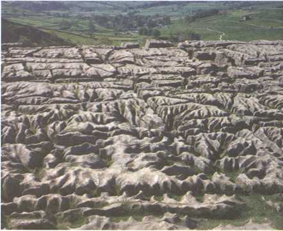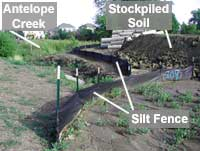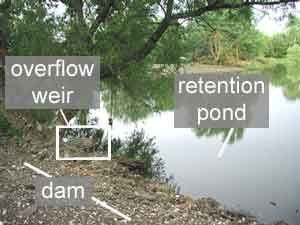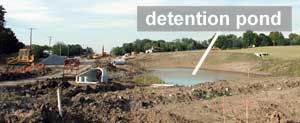Erosion may mean the wearing or washing away of something. Some of the forces which make soil can also erode the soil so that it is lost to the farmer.
Therefore, soil erosion is the removal of top soil by agents of soil erosion, such as rain, wind and flowing water. Soil conservation can be defined as the science and art of looking after the land in such a way that soil is retained in one place and not carried away by agents such as water, wind, and animals, including man.
Erosion involves the transport of weathered material. Wind, glaciers, rivers and seas all play a part in moving rocky debris and soil. They are called carriers. The material being transported can also cause further erosion by abrasion (rubbing).


Eventually the eroded material is deposited as pebbles, sand or mud. This happens as a result of gravity when the carrier slows down. As the wind drops, for instance, the dust settles. Rock debris will be eroded, transported or deposited by a river depending on the different speeds at which the river is flowing. For example, coarse sand will be eroded by a fast-flowing river. It will be transported by a slow-flowing river, and deposited by a very sluggish river. Rivers deposit sand and gravel when they lose speed:
- on the inside curves of rivers, and
- when a river flows into a lake or the sea.
Table of Contents
Types of Erosion
There are different types of soil erosion, namely: water erosion, sheet erosion, rill erosion, gulley, sedimentation, and wind erosion. Now let us look at what is involved on each one of them.
Water Erosion: This is usually caused by ‘run off water which carries top soil away.
Sheet Erosion: This is where water removes a thin layer or ‘sheet’ of soil, from sloping land. It is also called ‘splash erosion’ because heavy rain drops first loosen the bare soil and then soil is transported by running water down the hill.
Rill Erosion: A rill is a tiny channel in the soil made by running water. Rills remove the valuable top soil. If not stopped, they can soon become deeper and remove sub soil as well.
Gulley Erosion: A gulley is a deep channel made by running water. Gullies can develop from small hills with heavy rains on the steep slopes.
Sedimentation: Sediment is made of soil particles which are picked up by moving water, Sedimentation occurs when these soil particles are deposited on the lower land as the water stops moving. The sediment may be enough to cover crops growing in lower areas, and may fill reservoirs and ditches. It may also spoil low land soil by covering it with poor sediment sand.
Erosion by Wind and Sun: When soil is left bare, it is quickly dried up by the sun. The sun also destroys the humus which holds soil together. After this, the wind blows away the soil.
Causes of soil erosion
Soil erosion is caused by any of the following:
(a) Overgrazing- This is the result of overstocking or keeping a few animals on a piece of land for a very long time.
(b) Over cropping (over cultivation) – The same crop is repeatedly grown on a piece of land without rest. The organic matter content and soil fertility run down and, as a result, crops grown cannot form a dense cover. When it rains water erodes a lot of soil.
(c) Removal of vegetation– Careless removal of vegetation such as cutting down forests (deforestation) and burning bushland can lead to erosion. The vegetation which acts as a barrier against soil erosion is lost.
(d) Improper farming methods, such as:
(i) ploughing along the slope, i.e. ploughing up and down sloping land
(ii) planting crops along the slope
(iii) planting annual crops on very steep slopes
Methods of controlling soil erosion
There are many ways of controlling erosion so that soil can be conserved. Some of the ways are by following good methods of farming.
Erosion control is the practice of preventing or controlling wind or water erosion in agriculture, land development, coastal areas, river banks and construction. Effective erosion controls handle surface runoff and are important techniques in preventing water pollution, soil loss, wildlife habitat loss and human property loss. The ways by which soil may be conserved, are: re-forestation, late burning, correct stocking, crop rotation, using cover crops, inter-planting, mulching, winter ploughing, contour farming and terracing (Bench terracing).
1. Construction Erosion Control
A major component of construction is the clearing and grading of land, which exposes, disturbs, and moves the soil. This inevitably increases an area’s susceptibility to erosion. Since in these situations it is not feasible to eliminate all erosion risk factors and, thus, all erosion, the goal of implementing erosion control measures is primarily to minimise erosion.
The benefits of implementing effective erosion control measures include the reduction of soil washed off-site and reduced clogging of streets and drainage systems, as well as reduced damage to adjacent properties. There are several best management practices that can be implemented to reduce erosion in construction sites and minimise movement of sediment into drainage systems.
When soils have been disturbed, erosion can be minimised with one or more of the following treatments.
2. Vegetative Cover
Vegetative cover is efficient in reducing erosion and is a relatively inexpensive erosion control measure. Vegetative cover provides a canopy that covers the soil from the impacts of wind and water energy and a rooting system that holds soil particles together. Dense and short vegetative covers like grass are often more effective than tall and sparse vegetation for control of water erosion. Dense vegetation covers the soil surface and reduces the impact of energy of falling rain. On the other hand, dense and tall vegetative covers are more effective than short vegetation for control of wind erosion. This is because tall vegetation, depending on the wind speed, reduces the wind velocity, therefore, reducing its erosive energy.
(a) Maintaining or Preserving Vegetation:
Existing vegetation is the best antidote for erosion. Trees, shrubs, and grasses that do not interfere with the construction process should be left undisturbed or maintained to minimise damage. The more vegetation area that is preserved the less area exposed to erosion.
(b) Planting New Vegetation:
In areas of housing development, it is important to establish permanent vegetation to minimise soil exposure to water and wind erosion. Vegetation/plants that have fibrous root system with fast establishment of roots and ground cover are good options (see suggested list of shrubs).
Temporary Seeding is the planting of grasses or plant materials that will quickly germinate and grow into protective cover for the soil until a permanent planting is established. Temporary seeding is recommended during the land grading and construction processes. Rapidly growing plants such as annual grasses, small grains, or legumes are appropriate temporary seeding options. Temporary seeding protects the soil and reduces mud and dust produced during construction. Thus, it is a short-term erosion control measure (Less than 1 year).
Permanent Seeding is the establishment of the appropriate grasses or plants in the construction sites. Unlike temporary seeding, permanent seeding requires that the construction phase be complete. Only then more appropriate and/or desired plants are established. Thus, permanent seeding is for long-term control of soil erosion. If the season is not appropriate for permanent seeding, temporary seeding options are often considered to minimise bare soil exposure until permanent seeding can be done. Either temporary or permanent seeding can be done through hand seeding and/or hydroseeding. Hydroseeding is done if the land is especially steep and irregular for hand seeding.
(c) Mulching
Similar to seeding, mulching is a method of applying plant or non-plant materials to cover bare soil surface. The main goal of mulching is to protect the surface of the soil from the impact of erosive forces. In construction sites, mulch can be placed to minimise wind and water erosion. However, the type of mulching selection depends on the land (i.e., slope). Heavy and large sized mulch would be more appropriate for a steep slope. In steep or gentle slopes, matting can be done to hold the mulch in place and reduce its movement by wind or water.
Aside from protecting the soil from erosion, mulching conserves water and reduces soil temperature fluctuations. If the mulch is plant-based or organic, it also increases the soil tilth. For a table of the advantages and disadvantages of various mulch types, click the button below.
(d) Silt Fencing

Silt fencing is a temporary barrier placed along the perimeter of a construction site. Silt fence does not serve to prevent erosion; rather, it traps soil or sediment from leaving the perimeter of the construction site. To be effective, silt fence must be constructed carefully and be in place before construction begins. Silt fences are primarily intended for trapping sediment from water erosion. They are less effective for wind erosion because they are not tall enough barriers.
(e) Impoundments
Impoundments are man-made ponds or lakes constructed to control storm run-off and/or trap sediments. Before soil or sediment reach the drainage system, detention ponds can be placed to trap and settle sediments. This in effect is NOT an erosion preventive measure but a measure to minimise the already detached or eroded soil from entering waterways. It is a sediment control measure.
There are two kinds of impoundments: permanent ones called retention ponds and temporary ones called detention ponds.
A good example of a retention pond is Holmes Lake, which receives storm sewer water and runoff from the City of Lincoln. Holmes Lake serves to retain sediments before the water drains into Antelope Creek, Salt Creek, and eventually into the Platte River.


Detention ponds are small in area because they drain a relatively smaller area. Because construction changes the topography, or lay of the land, drainage characteristics of the land change. Detention ponds are often constructed during road or building construction because the removal of topsoil and compaction reduces water infiltration into the soil and increases the risk of runoff. In addition, paved roads and streets are impervious to water and often become a conduit for runoff and sediment to move into drainage systems.
(f) Wetlands
Wetlands are areas that are frequently saturated by surface water or groundwater, staying wet at least part of the year (i.e., swamps, bogs, fens, marshes, and estuaries). Wetlands are often natural but can also be constructed. Wetlands are effective at controlling sediment and filtering nutrients and other chemical pollutants because they are a biologically active system.


